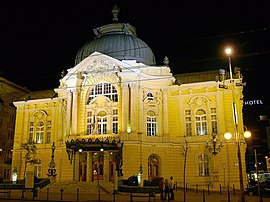Comedy Theatre of Budapest
 |
|
| Address | Szent István Street 14 |
|---|---|
| Location | Budapest, Pest county, Hungary |
| Coordinates | 47°30′45.21″N 19°3′5.03″E / 47.5125583°N 19.0513972°E |
| Type | Theatre |
| Capacity | 1000 |
| Construction | |
| Built | 1896 |
| Opened | 1896 |
| Website | |
| Vígszínház | |
The Comedy Theatre of Budapest (Hungarian: Vígszínház) is a theatre in Budapest. Starting in the turn of the 19th and 20th century as an opposition to the conservative National Theatre, it became a pioneer institution of Hungarian drama, and one of the oldest theatres of the city still in operation.
The Vígszínház was designed by architects Ferdinand Fellner and Hermann Helmer who worked on over 47 state-of-the-art theatre buildings around Europe. Its construction was financed by the tripartite ownership consisting of Count István Keglevich, the writer Ferenc Szécsi, and local businessman Gábor Faludi. I The destined area was a swampland before, but in the next few years it developed into the bourgeois Lipótváros district. The construction started in 1895 and lasted for one year, finishing on 1 May 1896. With 3 main tracts: the stage, including the flies; the lower seating tract; and the entry hall; the building exemplifies late historicism, featuring large sizes, an elevated driveway and baroque decorations, often using golden coloring. As a distinct feature from contemporary theatres, the Vígszínház featured three rows of box seats, large corridors and public areas supported by several wide stairs to answer the call of rising social life in the rapidly developing Budapest.
Mór Ditrói was the first director, coming from Kolozsvár (today Cluj-Napoca). He also brought his company of young actors, who were unknown to the Budapest audience at the time. They quickly created a unique and modern repertoire differing from the era's classical theatre, that featured both French comedies, contemporary Hungarian (starting the career of Ferenc Molnár, Sándor Bródy, or Jenő Heltai), and foreign (like from Irwine Shaw, Bertold Brecht, Anton Chekhov) dramas. The Vígszínház provided starting ground and home for several of the biggest names of the theatrical world from the turn of the century, like Gyula Csortos, Lili Darvas, Lili Muráti, Artur Somlay, Klári Tolnay or Gyula Kabos.
...
Wikipedia
